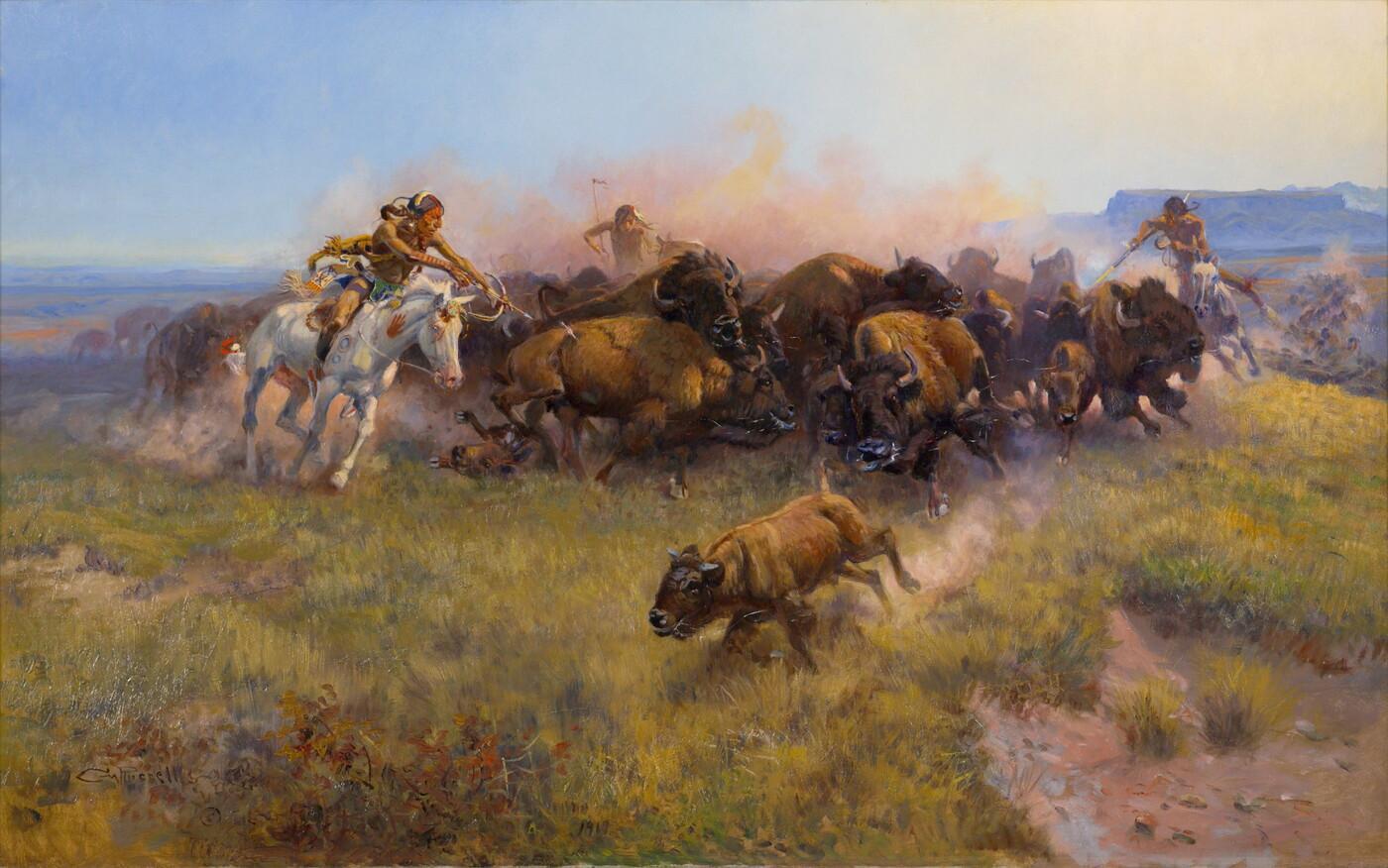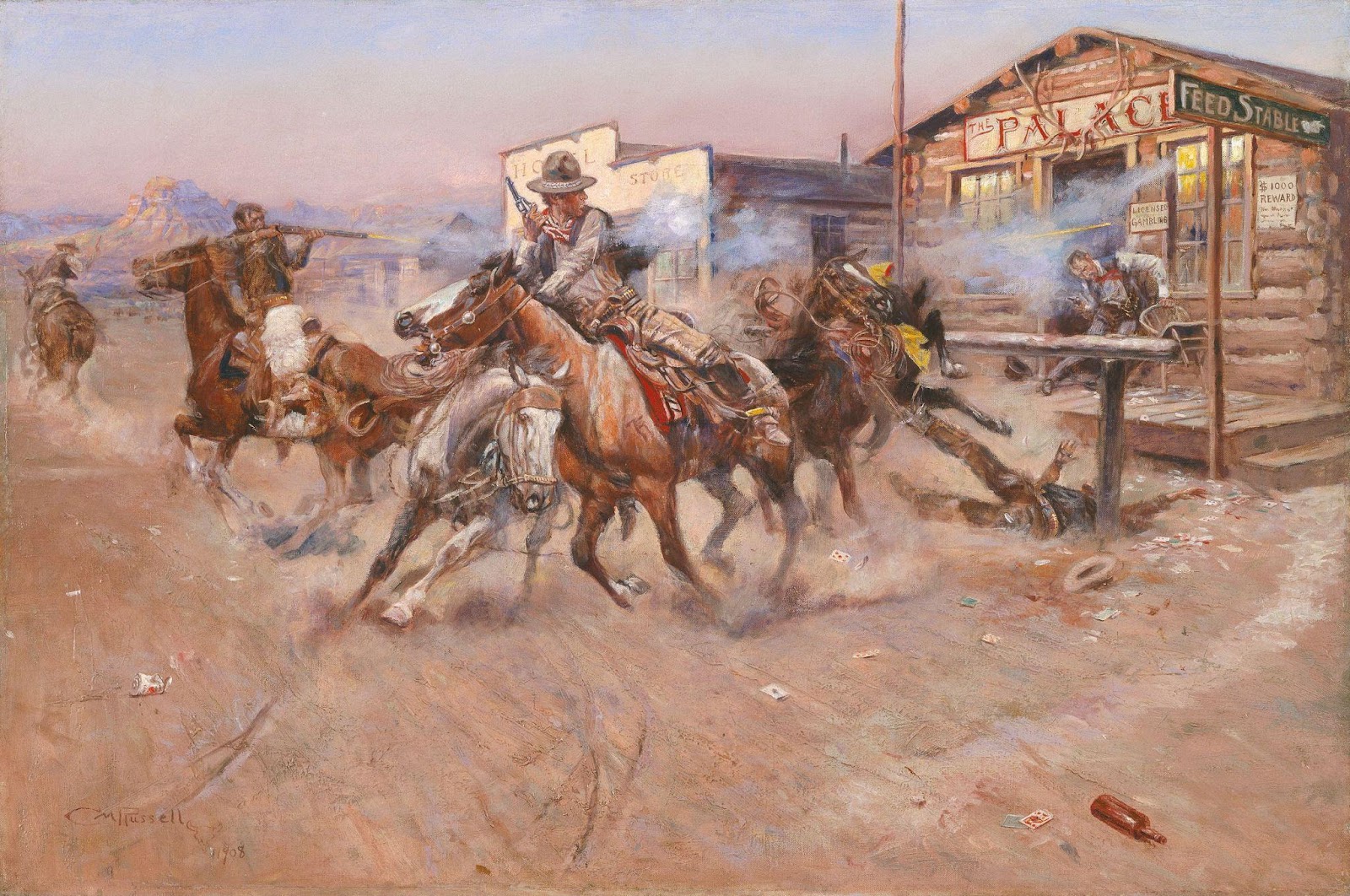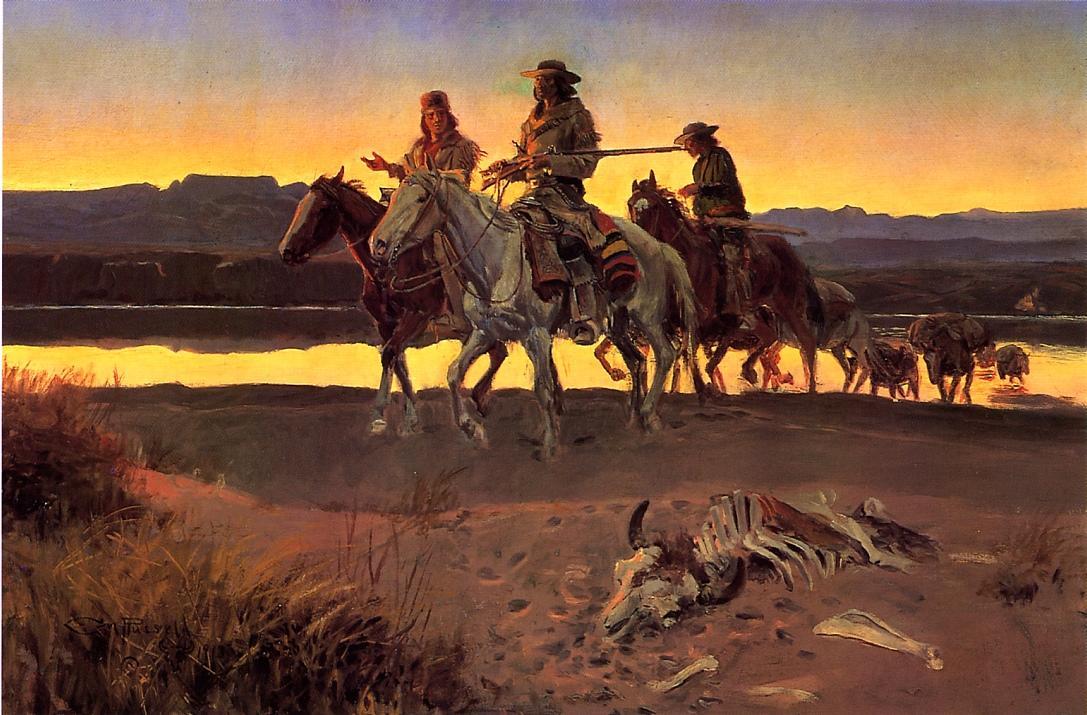Blog
Fascinating Facts About Charles Marion Russell

The Cowboy Artist
Charles Marion Russell, also known as “the Cowboy Artist,” was an American painter, sculptor, and illustrator known for his depictions of life in the American West. Russell was born in 1864 in St. Louis, Missouri, and spent much of his childhood on a farm in central Missouri. From a young age, he was fascinated by the cowboys and Indians he saw in books and illustrations and dreamed of becoming a cowboy himself.
In 1880, Russell moved to Montana to work as a cowboy on a ranch. It was during this time that he began to sketch and paint the people and landscapes of the American West. Russell’s early works were heavily influenced by the work of Frederic Remington, another famous Western artist, whom Russell greatly admired.
Russell’s paintings and sculptures often depicted the everyday life of cowboys, Native Americans, and other Westerners. He was particularly known for his depictions of cowboys on horseback, as well as his detailed portrayals of the clothing, tools, and weapons used by Westerners in the late 1800s and early 1900s.
One of Russell’s most famous works is “The Bronc Twister,” a painting that shows a cowboy riding a bucking bronco. The painting is notable for its dynamic composition and the way it captures the energy and movement of the horse and rider.
In addition to his paintings, Russell also created sculptures of Western subjects. One of his most famous sculptures is “The Buffalo Hunt,” which depicts a group of Native Americans hunting buffalo on horseback. The sculpture is notable for its detailed depiction of the hunters, horses, and buffalo, as well as its realistic portrayal of the action and movement of the scene.
Russell’s work was popular during his lifetime and continues to be celebrated today. In 1923, he helped establish the Montana Historical Society, which now includes the Russell Gallery and Museum in Great Falls, Montana. The museum features many of Russell’s paintings and sculptures, as well as exhibits on the history and culture of the American West.
Russell’s Love for the Wild West
Charles Marion Russell had a deep love for the Wild West, which was reflected in his artwork. As a young man, Russell was captivated by the tales of cowboys, Indians, and frontiersmen that he read in books and saw in illustrations. When he moved to Montana in 1880 to work as a cowboy, he was able to experience firsthand the rugged beauty and excitement of life in the West.
Russell’s love for the Wild West was not just a passing interest; it was a lifelong passion that he would later channel into his art. He spent much of his time observing and interacting with cowboys and Indians, learning their customs, and studying their way of life. He also traveled extensively throughout the West, from Montana to Arizona, gathering inspiration for his paintings and sculptures.
One of the things that Russell loved most about the Wild West was the sense of freedom and adventure that it offered. He saw the West as a place where a man could make his own way, and he admired the courage and tenacity of the people who lived there. He often depicted cowboys and Indians in his artwork as heroic figures, battling the elements and overcoming obstacles to survive and thrive in a harsh and unforgiving landscape.
Russell’s love for the Wild West was also rooted in his appreciation for its natural beauty. He was particularly drawn to the wide-open spaces, rugged mountains, and vast expanses of prairie that characterized much of the West. He painted many landscapes that captured the grandeur and majesty of the Western scenery, often depicting them with an eye for detail and a keen sense of composition.
One of the reasons why Russell’s artwork continues to resonate with people today is that it captures the spirit of the Wild West in a way that is both authentic and romantic. He was able to convey the beauty, danger, and excitement of life in the West, while also celebrating the values of courage, independence, and self-reliance that were so important to the people who lived there.
The Russell Gallery and Museum
The Russell Gallery and Museum, located in Great Falls, Montana, is a tribute to the life and work of Charles Marion Russell, one of America’s most beloved Western artists. The museum was established in 1953, and since then it has become a popular destination for art lovers, Western enthusiasts, and tourists from around the world.
The museum is housed in a historic building that was once the home of Russell and his wife, Nancy. The building has been beautifully restored, with many of the original furnishings and decorations preserved. Visitors to the museum can explore the rooms where Russell lived and worked, getting a glimpse into the daily life of this iconic artist.
The museum’s collection includes over 2,000 works by Russell, including paintings, sculptures, sketches, and letters. Many of these works are on display in the galleries, providing visitors with an opportunity to see firsthand the breadth and depth of Russell’s artistic output. The works on display cover a wide range of subjects, from cowboys and Indians to wildlife and landscapes.
One of the most impressive aspects of the museum is the collection of Russell’s sculptures. Russell was a skilled sculptor, and his works are renowned for their lifelike detail and dynamic compositions. Many of his sculptures depict Western scenes, such as cowboys on horseback, Native Americans hunting, and animals in motion. Visitors to the museum can see these sculptures up close, appreciating the skill and artistry that went into creating them.
In addition to the galleries, the museum also features a research library, a gift shop, and a theater that shows films and documentaries about Russell and the American West. The research library is a valuable resource for scholars and researchers, with a collection of books, manuscripts, and photographs related to Russell and Western art.
The museum also hosts a variety of events and activities throughout the year, including lectures, workshops, and family programs. These events are designed to engage visitors of all ages and backgrounds, providing a deeper understanding of Russell’s work and the history and culture of the American West.
Conclusion
Charles Marion Russell was an artist whose work captured the spirit and essence of the American West. He lived during a time of great change and transformation in the West, and he was able to convey through his art the beauty, danger, and excitement of life in this unique region.
Russell’s life and career were marked by many interesting facts and achievements. He was a self-taught artist who went on to become one of the most celebrated Western artists of all time. He lived and worked in Montana for most of his life, surrounded by the very cowboys, Indians, and frontiersmen who inspired his art. He was a skilled painter, sculptor, and storyteller, and his works have continued to captivate audiences long after his death.
Russell’s legacy extends far beyond his art, however. He was a man of great integrity and character, and his values of courage, independence, and self-reliance are reflected in his art. He was also a conservationist who recognized the importance of preserving the natural beauty of the West, and he used his art to advocate for the protection of the region’s wildlife and wilderness areas.
Today, Russell’s work continues to inspire and captivate people around the world. His paintings and sculptures are cherished by collectors and Western enthusiasts, and his influence can be seen in the work of many contemporary artists. The Russell Gallery and Museum in Great Falls, Montana, serves as a testament to Russell’s enduring legacy, providing visitors with an opportunity to experience his art and learn about his life and career.
In a world that is constantly changing and evolving, Charles Marion Russell’s art and values remain as relevant and inspiring as ever. His work reminds us of the importance of preserving our natural and cultural heritage, and of the enduring spirit of the American West.
-
Blog1 year ago
MyCSULB: Login to CSULB Student and Employee Portal – MyCSULB 2023
-
Android App3 years ago
Cqatest App What is It
-
Android1 year ago
What Is content://com.android.browser.home/ All About in 2023? Set Up content com android browser home
-
Software2 years ago
A Guide For Better Cybersecurity & Data Protection For Your Devices
-
Latest News2 years ago
Soap2day Similar Sites And Alternatives To Watch Free Movies
-
Android2 years ago
What is OMACP And How To Remove It? Easy Guide OMACP 2022
-
Android3 years ago
What is org.codeaurora.snapcam?
-
Business2 years ago
Know Your Business (KYB) Process – Critical Component For Partnerships























